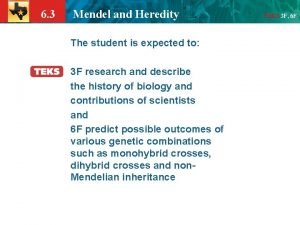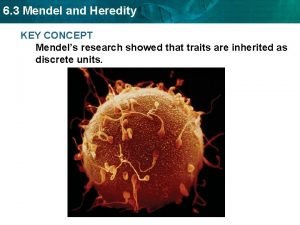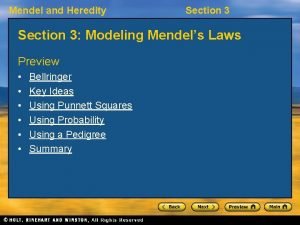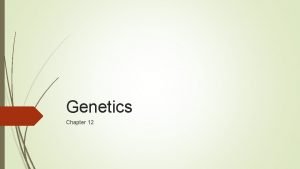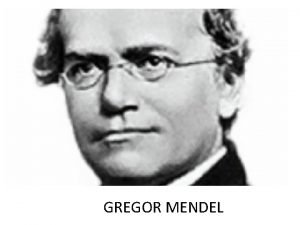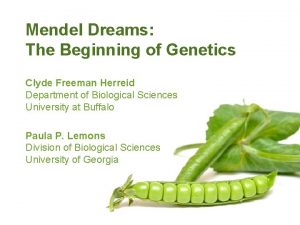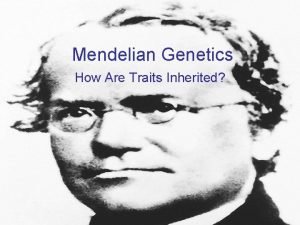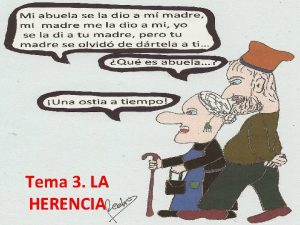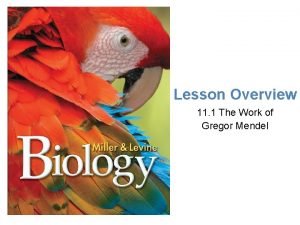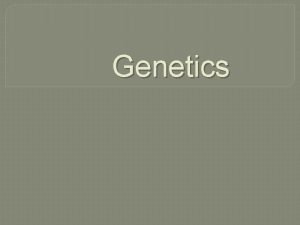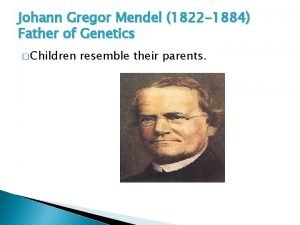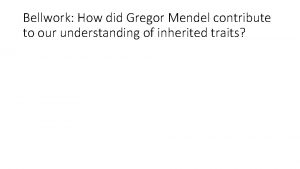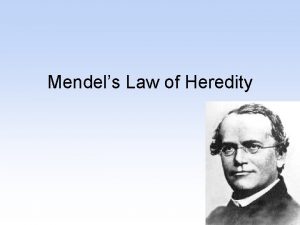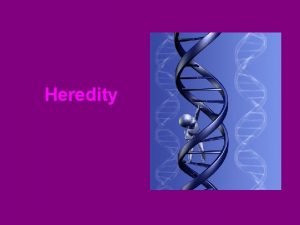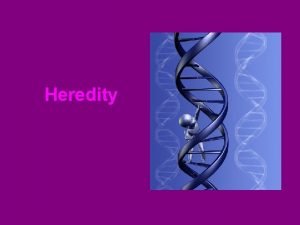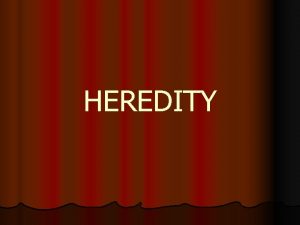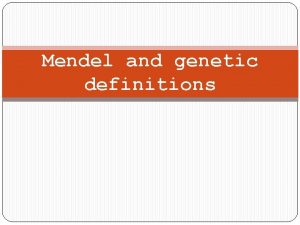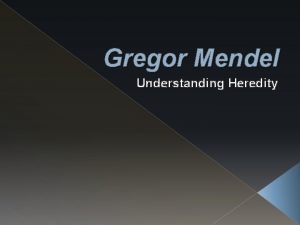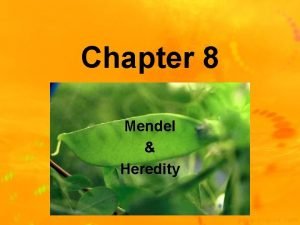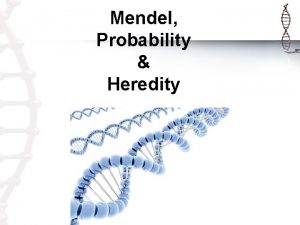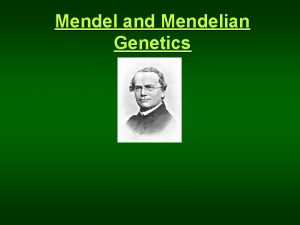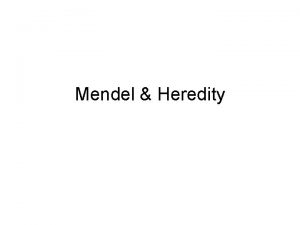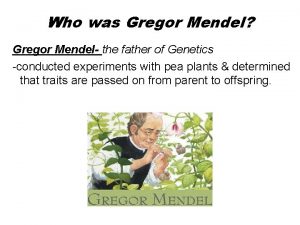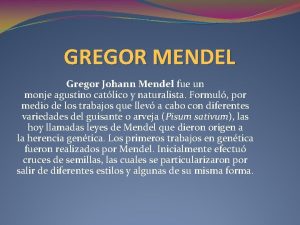Mendel Heredity 1 Gregor Mendel Gregor Mendel was


















- Slides: 18

Mendel & Heredity 1

Gregor Mendel • Gregor Mendel was born in 1822 to peasant parents in what is now the Czech Republic. • He became part of a monastery and was in charge of the monastery’s garden. • Mendel discovered the basic principles of heredity by breeding garden peas in carefully planned experiments.

Mendel’s Experiments • Over time, Mendel learned how to prevent the self-pollination of the pea plants. • Instead, Mendel controlled the pollination of plants by using an artist’s brush. He transferred the pollen from one flower to the flower of another selected plant.

Mendel’s Experiments 4 • Mendel used this technique to breed pea plants with specific characteristics. • Through a series of carefully designed experiments, Mendel crossed plants with different traits to see what traits the offspring would have. • These offspring are called hybrids – offspring of parents with different traits.

Mendel’s Experiments: Traits Studied Seed Shape Seed Color Pod Shape Pod Color Seed Coat Color Plant Height Flower Position Axial Round Yellow Smooth Green Gray Tall Terminal Wrinkled Green Constict Yellow White Short In order to keep his experiments simple, Mendel decided to study seven isolated traits within a pea plant.

Mendel’s Experiments: F 1 Generation P Generation F 1 Generation • • One of Mendel’s first experiments crossed two plants with different seed colors (Yellow & Green). These plants are called the parental generation (P Generation). The offspring were all called the 1 st filial generation (F 1 Generation). The offspring (F 1 Generation) of these parent plants all had yellow seeds.

Mendel’s Experiments: F 2 Generation P 1 F 2 • Next, Mendel crossed two plants from the F 1 Generation • The offspring from this cross are called the 2 nd filial generation (F 2 Generation) • After taking careful count, Mendel noticed that most of the seeds in F 2 Generation were still yellow, but a small number were green. • After completing hundreds of more experiments with other traits, Mendel found this ratio to be approximately, 3 to 1.

Mendel to Modern Heredity 1. Mendel stated that “factors, ” which do not blend together, control each trait of a living thing. Each parent contributes one of these factors to their offspring. Today, we call these factors genes. 2. A gene is a section of DNA that codes for one protein. Genes are what control & produce traits. The genes Mendel studied came in two forms (tall/short; round/wrinkled seeds; yellow/green; etc) 3. Alternative forms of the same gene are called alleles (yellow/green, wrinkled/smooth, etc). 4. Some genes are dominant and some are recessive. The effects of a dominant allele are always seen if it is present. The effects of a recessive allele is not seen when the dominant allele is present.

Further Findings • So, each trait is controlled by a gene, and each gene has two alleles. • If the two alleles are the same, they are said to be homozygous. If they are different, they are referred to as heterozygous. • Dominant alleles are represented with a capital letter, while recessive alleles with a lower case letter. YY Yy yy Homozygous Dominant Heterozygous Dominant Homozygous Recessive

The Rule of Dominance • A dominant trait is the trait that will always be expressed if at least one dominant allele is present. • The dominant allele is always represented by a capital letter. • A recessive trait will only be expressed if both alleles are recessive. • Recessive traits are represented by a lower case letter.

Law of Segregation • This principle states that the alleles for a trait separate when gametes are formed. These allele pairs are then randomly united at fertilization. • Alleles are now known to be found on copies of chromosomes – one from each parent. Allele for purple flowers Locus for Flower-color gene Homologous pair of chromes Allele for white flower

More Findings These alleles are separated during the formation of an organism’s reproductive cells (sperm and eggs). Then, when the egg and sperm joined, each organism would have one allele from each parent. Yy Yy Y y YY Yy Yy yy

An Example F 1 Generation F 2 Generation YY FATHER MOTHER Yy Yy Yy yy • The law of dominance explained the heredity of the offspring of the F 1 Generation • The law of segregation explained the heredity of the F 2 Generation

Phenotypes & Genotypes • Phenotype – the physical appearance of an organism; the way it looks (tall/ short, green/yellow, blue or brown eyes, etc. ) • Genotype – The genetic combination (combination of alleles) of an organism (i. e. – YY, Yy, yy) – Homozygous – both alleles are the same – Heterozygous – each allele is different Pea pod phenotypes YY yy Pea pod genotypes

Punnett Squares: Monohybrid Crosses Punnett Squares are a shorthand way of showing how alleles behave and a prediction of an expected genetic outcome. Tt 2. Place the genotype of one parent across the top and the genotype of the other on the left side. Tt 1. Draw a big square and divide it into fours.

Punnett Squares: Monohybrid Crosses 3. Place one allele at the side or top of each square 4. Populate each square with the corresponding alleles Tt t T TT Tt tt Tt T

Questions 1. How many different genotypes are present in this generation? 2. How many tall plants are in this generation? Tt t T TT Tt tt Tt T

Questions 18
 Section 3 mendel and heredity
Section 3 mendel and heredity Section 3 mendel and heredity
Section 3 mendel and heredity Section 3 mendel and heredity
Section 3 mendel and heredity Section 3 mendel and heredity
Section 3 mendel and heredity Section 3 mendel and heredity
Section 3 mendel and heredity The work of gregor mendel lesson 1 chapter 12
The work of gregor mendel lesson 1 chapter 12 Mendels theory
Mendels theory Gregor mendel
Gregor mendel Gregor mendel
Gregor mendel Rryy x rryy
Rryy x rryy Gregor mendel laws
Gregor mendel laws Gregor mendel
Gregor mendel Guisantes mendel
Guisantes mendel Gregor mendel
Gregor mendel What did gregor mendel research
What did gregor mendel research Gregor mendel
Gregor mendel Section 11-1 the work of gregor mendel
Section 11-1 the work of gregor mendel How did gregor mendel contribute to genetics
How did gregor mendel contribute to genetics Chapter 11 biology review answers
Chapter 11 biology review answers
